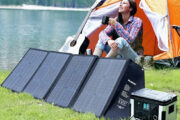If you ask me, the best part of camping is when the sun goes down. I simply love gathering around the campfire. The stories get scarier, the s’mores sweeter and the surroundings even more mysterious. But unfortunately, our vision gets significantly worse in the dark. As the glow of the campfire and the twinkling of the stars are simply not enough, it’s important to choose the right camping lights to stay safe and keep all the fun going.

Types of Lights
There’s a variety of lights on the market depending on what you need them for. Generally, camping lights fall in one of two categories: area lighting and directional lighting. Area lighting mainly consists of lanterns that can provide a 360 degree of illumination which is useful for multiple people. On the other hand, directional lighting consists of flashlights and headlamps which are perfect for lighting the way. Headlamps are usually considered much convenient to use as they free up the hands so you can set up the tent, collect wood, or cook.
Choosing Bulbs
Both directional and area lighting use a variety of bulbs. Depending on the type of bulb used, there are incandescent, CFL and LED camping lights. Incandescent lights are the least expensive, however, they also waste a lot of energy and generate more heat. CFL lights, on the other hand, are more energy-efficient than incandescent, however, they are easily damaged and have a generally short lifespan. LED camping lights are usually the best choice as they are the most energy-efficient and durable. Due to their innovative design, LED camping lights are cool to the touch and safe to use and store. With an average lifespan of 50 000 hours of use, they are definitely a worthy investment.
Intensity of Light
The intensity of the light is measured in lumens. So, the higher the number of lumens, the brighter the light will be. This is a very important factor for choosing directional lights used for mountain biking or other outdoor tasks that require great precision. But also keep in mind that the more powerful the light is, the less energy-efficient it will be. So, if you’re planning to get a light with 1000+ lumens, and LED model may be the most efficient option.
Power Source
Camping lights are usually battery-operated or rechargeable. When opting for battery-operated lights always make sure you have extra batteries available. While rechargeable camping lights are also battery operated, their batteries can be easily recharged by plugging them into a power outlet in your car or RV. Some rechargeable camping lights can also be solar powered. There are also lanterns powered by propane or lamp oil, however, they aren’t very safe as they can emit a lot of heat and can pose a fire hazard.


